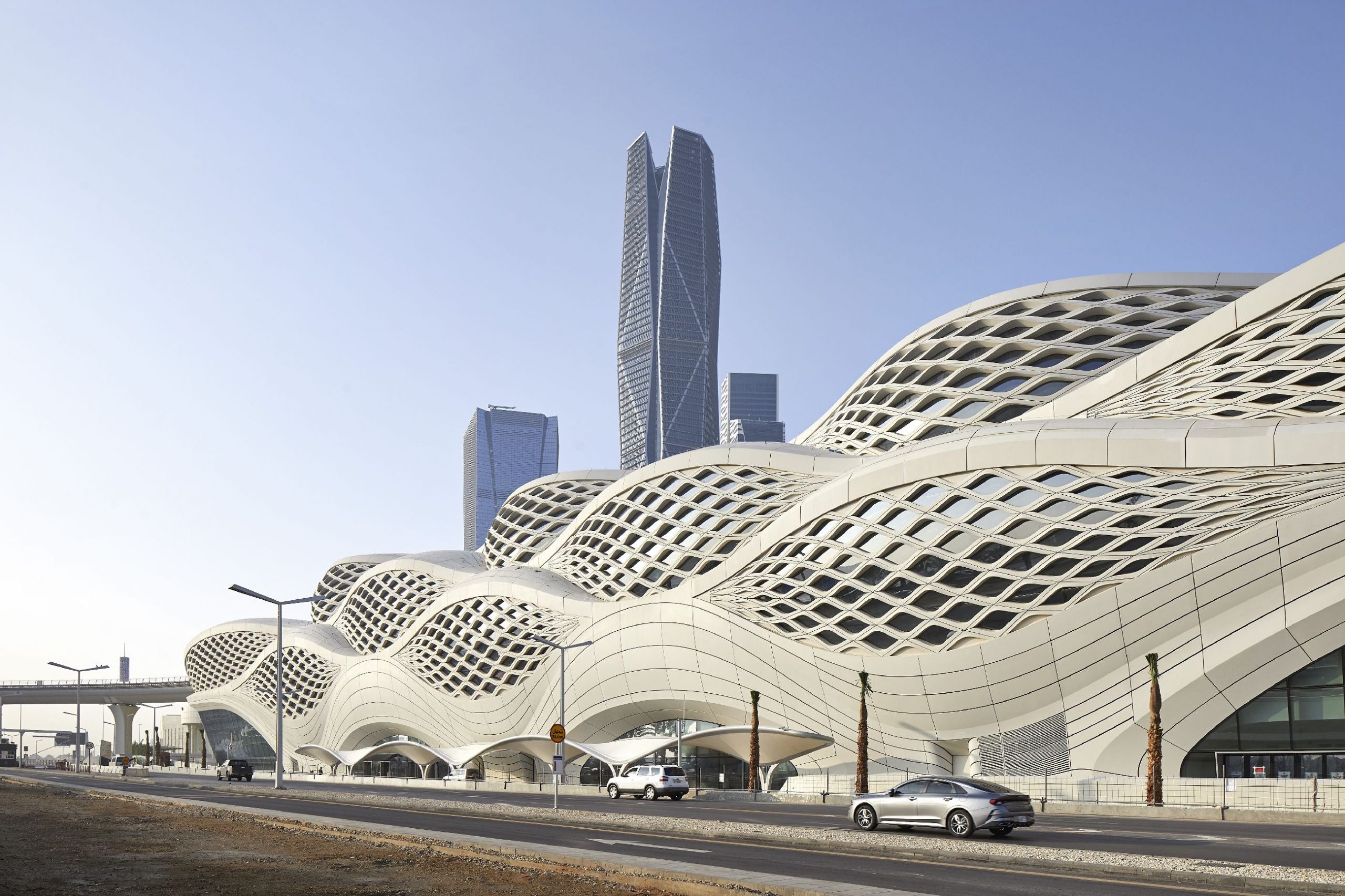The world’s longest driverless transit system, the Riyadh Metro network spans over 176 kilometres across 6 lines and 85 stations. With a capacity of 3.6 million daily passengers, Riyadh Metro will reduce the number of car journeys throughout the city and encourage the use of sustainable modes of transport. Designed by Zaha Hadid Architects, the King Abdullah Financial District Metro Station serves as the key interchange on the network.

Riyadh Metro network starts serving passengers on Sunday, December 1st, 2024 with the opening of its Blue, Yellow and Purple lines (Lines 1, 4 and 6), will alleviate traffic congestion, shorten travel times and improve quality of life for Riyadh’s growing population. As the world’s longest driverless transit system, the transformative network spans over 176 kilometres across 6 lines and 85 stations, connecting key districts, business centres, and cultural landmarks in Saudi Arabia’s capital city.

An automated rapid transport system planned by the Royal Commission for Riyadh City (RCRC), Riyadh Metro will meet the needs of residents and visitors alike. With a capacity of 3.6 million daily passengers, the network will reduce the number of car journeys throughout the city and encourage the use of sustainable modes of transport.

The King Abdullah Financial District (KAFD) Metro Station, designed by Zaha Hadid Architects (ZHA), serves as the key interchange on the new network, connecting the KAFD terminus, King Khalid International Airport, and providing access to the skybridge for the local KAFD monorail. The station’s six rail platforms over four levels connect with bus and park-and-ride services to create an important multi-modal transport hub for the city, as well as new indoor and outdoor public plazas for the financial district.

Contributing to the identity of Riyadh’s new metro system, the KAFD Metro Station’s design prioritizes connectivity. The station’s predicted rail, car and pedestrian traffic has been modelled, mapped and structured to optimize internal circulation and avoid congestion. The resulting configuration is a three-dimensional lattice defined by a sequence of opposing sinewaves (generated from the repetition and frequency variation of the station’s daily traffic flows), which act as the spine for the building’s circulation.

These sinewaves extend to the station’s exterior clad in ultra-high-performance concrete panels. The façade’s geometric perforations reduce solar gain as a contemporary reinterpretation of traditional environmental sheltering within the region’s vernacular architecture. The composition of the station’s façade echoes the patterns generated by desert winds in sand, where multiple frequencies and reverberation generate the complex repetition of patterns evident in the natural world.

The KAFD Metro Station is composed as a set of elements that are highly correlated through repetition, symmetry and scale. The design was continually optimized by ZHA throughout its development to increase structural efficiencies and environmental performance while also simplifying the construction process without compromising spatial quality; seamlessly integrating the self-supporting structure of its external envelope with the station’s internal structure which supports the train platforms and viaducts.

Providing optimal comfort at minimum energy demand, the station combines effective passive design features with a high-efficiency cooling system that is powered by renewables and automatically adjusts to differing passenger levels throughout the day, while sliding door panels on each platform retain cool air within the station. The KAFD Metro Station has achieved Leadership in Energy and Environmental Design (LEED) Gold certification by the US Green Building Council.

Foto-foto lainnya dapat dilihat di galeri bawah ini
Architect: Zaha Hadid Architects (ZHA)
ZHA Design: Zaha Hadid with Patrik Schumacher
ZHA Project Principal: Gianluca Racana
ZHA Project Director: Filippo Innocenti
ZHA Project Architect: Gian Luca Barone
ZHA Project Associate: Fulvio Wirz
ZHA Construction Support Leads: Marco Amoroso, Domenico di Francesco
ZHA Construction Support Services: Vincenzo Caputo, Abdel Halim Chehab, Marko Gligorov, Stefano Iacopini
ZHA Project Team: Marco Amoroso, Vincenzo Caputo, Abdel Halim Chehab, Lee Cubeddu, Rawan Al-Derjem, Domenico Di Francesco, David Fogliano, Manuele Gaioni, Marko Gligorov, Subharthi Guha, Alexandros Kallegias, Lisa Kinnerud, Alexandre Kuroda, Stefano Iacopini, Carolina López-Blanco, Jamie Mann, Mohammadali Mirzaei, Arian Hakimi Nejad, David Wolthers, Nicola McConnell, Mario Mattia, Massimo Napoleoni, Niki Okala, Carlos ParragaBotero, Sohith Perera, Izis Salvador Pinto, Carine Posner, Neil Rigden, Paola Salcedo, Nima Shoja, Thomas Sonder, Vincenzo Reale, Kate Revyakina, Roberto Vangeli, Seungho Yeo
ZHA Competition Team: Alexandre Kuroda, Fei Wang, Lisa Kinnerud, Jorge Mendez-Caceres
Structural Engineer: BuroHappold
Building Services Engineer: BuroHappold
Transport & Civil Engineers: BuroHappold
Fire Protection & Life Safety Engineer: BuroHappold
People Flow: BuroHappold
Acoustic Consultant: BuroHappold
Sustainability Consultant: BuroHappold
Lighting Consultant: BuroHappold
Façade Engineering: Newtecnic
Design Management: AECOM
Specification Consultant: AECOM
Cost Consultant: AECOM
Signage & Way Finding: Transport Design Consultancy
Safety Assessment: BH with Transsol
Development Engineer: Riyadh Metro Transit Consultants (RMTC)
Main Contractor: BACS Consortium
Independent Checking Engineer: Buro Veritas
Independant Safety Assessor: TÜV Rheinland / ISARail Group
Viaducts: AECOM & TriPod-ssd (Line1), Atkins (Line 4&6)
Automatic Fare Collection: Indra
Structure Contractor: Saudi Lebanese Tarouk Contracting
MEP Contractor: Zamil
Interiors Contractor: DEPA
Landscape Contractor: DEPA
Photographers: Hufton + Crow

